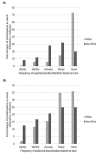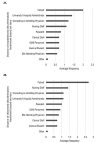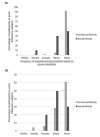Academic Emergency Medicine Faculty Experiences with Racial and Sexual Orientation Discrimination
- PMID: 32970570
- PMCID: PMC7514380
- DOI: 10.5811/westjem.2020.6.47123
Academic Emergency Medicine Faculty Experiences with Racial and Sexual Orientation Discrimination
Abstract
Introduction: Despite the increasing diversity of individuals entering medicine, physicians from racial and sexual minority groups continue to experience bias and discrimination in the workplace. The objective of this study was to determine the current experiences and perceptions of discrimination on the basis of race and sexual orientation among academic emergency medicine (EM) faculty.
Methods: We conducted a cross-sectional survey of a convenience sample of EM faculty across six programs. Survey items included the Overt Gender Discrimination at Work (OGDW) Scale adapted for race and sexual orientation, and the frequency and source of experienced and observed discrimination. Group comparisons were made using t-tests or chi-square analyses, and relationships between race or sexual orientation, and we evaluated physicians' experiences using correlation analyses.
Results: A total of 141 out of 352 (40.1%) subjects completed at least a portion of the survey. Non-White physicians reported higher mean racial OGDW scores than their White counterparts (13.4 vs 8.6; 95% confidence interval (CI) for difference, -7.7 - -2.9). Non-White EM faculty were also more likely to report having experienced discriminatory treatment based on race than were White EM faculty (48.0% vs 12.6%; CI for difference, 16.6% - 54.2%), although both groups were equally likely to report having observed race-based discrimination of another physician. EM faculty who identified as sexual minorities reported higher mean sexual minority OGDW scores than their heterosexual counterparts (11.1 vs 7.1; 95% CI for difference, -7.3 - -0.6). There were no significant differences between sexual minority and heterosexual faculty in their reports of experiencing or observing discrimination based on sexual orientation.
Conclusion: EM faculty from racial and sexual minority groups perceived more discrimination based on race or sexual orientation in their workplace than their majority counterparts. EM faculty regardless of race or sexual orientation were similar in their observations of discriminatory treatment of another physician based on race or sexual orientation.
Conflict of interest statement
Figures




Similar articles
-
#MeToo in EM: A Multicenter Survey of Academic Emergency Medicine Faculty on Their Experiences with Gender Discrimination and Sexual Harassment.West J Emerg Med. 2020 Feb 21;21(2):252-260. doi: 10.5811/westjem.2019.11.44592. West J Emerg Med. 2020. PMID: 32191183 Free PMC article.
-
Workplace Harassment, Cyber Incivility, and Climate in Academic Medicine.JAMA. 2023 Jun 6;329(21):1848-1858. doi: 10.1001/jama.2023.7232. JAMA. 2023. PMID: 37278814 Free PMC article.
-
Prevalence of Discrimination, Abuse, and Harassment in Emergency Medicine Residency Training in the US.JAMA Netw Open. 2021 Aug 2;4(8):e2121706. doi: 10.1001/jamanetworkopen.2021.21706. JAMA Netw Open. 2021. PMID: 34410392 Free PMC article.
-
Discrimination Toward Physicians of Color: A Systematic Review.J Natl Med Assoc. 2020 Apr;112(2):117-140. doi: 10.1016/j.jnma.2020.02.008. Epub 2020 Mar 18. J Natl Med Assoc. 2020. PMID: 32197899 Free PMC article.
-
Immigration and Race: A Challenge of Many Shades.Child Adolesc Psychiatr Clin N Am. 2022 Apr;31(2):327-342. doi: 10.1016/j.chc.2022.01.004. Child Adolesc Psychiatr Clin N Am. 2022. PMID: 35361368 Review.
Cited by
-
Promoting Cancer Health Equity: A Qualitative Study of Mentee and Mentor Perspectives of a Training Program for Underrepresented Scholars in Cancer Health Disparities.Int J Environ Res Public Health. 2022 Jun 19;19(12):7512. doi: 10.3390/ijerph19127512. Int J Environ Res Public Health. 2022. PMID: 35742763 Free PMC article.
-
Doubly Marginalized: Addressing the Minority Stressors Experienced by LGBTQ+ Researchers Who Do LGBTQ+ Research.Health Educ Behav. 2022 Dec;49(6):960-974. doi: 10.1177/10901981221116795. Epub 2022 Aug 16. Health Educ Behav. 2022. PMID: 35972197 Free PMC article.
-
Diversity, Equity, and Inclusion Efforts at a Departmental Level: Building a Committee as a Vehicle for Advancing Progress.J Clin Psychol Med Settings. 2023 Jun;30(2):356-379. doi: 10.1007/s10880-021-09809-w. Epub 2021 Sep 16. J Clin Psychol Med Settings. 2023. PMID: 34529234 Free PMC article.
-
What Is the Representation of Sexual and Gender Minority Identities Among Orthopaedic Professionals in the United States?Clin Orthop Relat Res. 2024 Aug 1;482(8):1313-1321. doi: 10.1097/CORR.0000000000003079. Epub 2024 Apr 24. Clin Orthop Relat Res. 2024. PMID: 39031036 Free PMC article.
-
Emergency care of LGBTQIA+ patients requires more than understanding the acronym.AEM Educ Train. 2022 Jun 23;6(Suppl 1):S52-S56. doi: 10.1002/aet2.10750. eCollection 2022 Jun. AEM Educ Train. 2022. PMID: 35783082 Free PMC article.
References
-
- Association of American Medical Colleges. Total U.S. Medical School Enrollment by Race/Ethnicity and Sex. 2019. [Accessed December 4, 2019]. Available at: https://www.aamc.org/system/files/2019-11/2019_FACTS_Table_B-3.pdf.
-
- Palepu A, Carr PL, Friedman RH, et al. Minority faculty and academic rank in medicine. JAMA. 1998;280(9):767–71. - PubMed
-
- Fang D, Moy E, Colburn L, et al. Racial and ethnic disparities in faculty promotion in academic medicine. JAMA. 2000;284(9):1085–92. - PubMed
